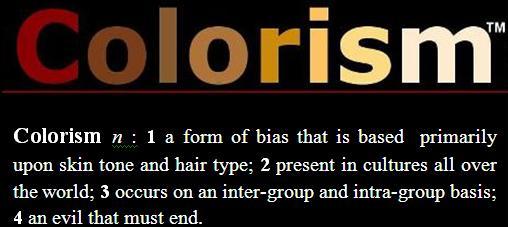For most of the long Independence Day Holiday, I was “takin’ a (generous) bite outta” the Big Apple! (LOL) And at one of the parties I attended, an incident got deep under my skin and really rankled me.
This particular soiree was interracial: roughly, the breakdown was 50% Black, 30 % Caucasian and 20 % Latino/Blatino. And, it was mostly a “singles thang;” which meant that more than a few of the “menz” were “on the prowl!” (LOL)
As I socialized, I heard inane and nauseating crap like:
“Oh no, dahling! I can’t get down (in more ways than one, if you catch my drift!) with that one! He’s much too dark. Now, if he wasn’t, well…” A brotha with a paper-brown complexion uttered that insulting drivel to his buddy.
“Nah, that guy’s much too ‘black’ for my tastes! (Pause.) And don’t you think his features are too…‘African’?” A white guy delivered that assessment to his group of “flamers.”
Shaking my head, I ruminated: “’Gawd, dang’! We are in the year 2017, aren’t we?” After I shook my head a couple of times, my spirit rejoined the “ju-say par-tay,” filled to the brim with mucho eye candy.
However, what I heard became lodged in the recesses of my fertile mind.
The term colorism sounds innocuous, a little exotic—you think?
Well actually, not by a long shot.
Colorism is an insidious form of racial discrimination that continues to be waged against African-Americans. Born during the advent of slavery, colorism is the practice of using the differences in complexions to pit one group of oppressed people of color against another—a strategy of “divide and conquer.” It was an effective “skin tone scheme” that the slaves had to adopt in order to survive.
Colorism is a form of racial discrimination in which individuals are accorded different social status and treatment based on skin color. As well, the term is used to label the phenomenon of persons discriminating within their own ethnic groups.
When African-Americans level it against one another—weaponize it, if you will—they are practicing self-hatred. It’s racism internalized. You see, these Blacks believe that anything white is superior, the best of the best.
Now, let’s delve deeper into this crippling, destructive malady.
We Definitely Ain’t Talkin’ ‘Bout Crayola Crayons Here

Colorism is based on the ideal that an individual’s worth is directly related to the color of his or her skin, valuing lighter hues over darker ones. Armstrong Williams, conservative African-American columnist, media personality and entrepreneur, has stated, “This brand of racism is particularly insidious because it is subtle. Unlike the time when racists donned pointed hats and stomped down the streets, the colorist is subtle, their contempt concealed beneath the still waters of social etiquette.”
In “The Color Complex: The Politics of Skin Color Among African-Americans,” co-author Dr. Midge Wilson traced the origins of colorism, and laid out its devastating implications and ramifications. “To understand the root of this deviant behavior, we have to go back to when slavery was in full effect,” she wrote. “Fair-skinned slaves automatically were selected for the better jobs, which were located in the master’s house. After gaining the trust of their masters, many of these fair-skinned slaves traveled throughout the nation and abroad with their masters and families, therefore affording them the opportunity to be exposed to the finer things, and many became educated as a result.”
Dr. Wilson continued, “The darker-tone peers labored relentlessly in the fields. They were the ones who were beaten, burned and hanged, the ones permanently condemned to be the lowest of the low in U.S. society. For them, even the three ‘Rs’—reading, ‘riting, ‘rithmetic—were illegal. Consequently, these actions resulted in a caste system. It seems the closer you were to your master, the better off you were—‘good’ hair, good clothes, good jobs, and an education were an inevitable result from those actions.” Prior to the Civil War, social status among Blacks was strongly associated with skin color.
Blue Veins…and Paper Bags
Twelve years ago, the ABC news program “20/20” aired “Skin-Deep Discrimination: Colorism Shows We’re a Long Way from a Color-Blind Society.” The program reported that historians state that friction between Blacks of different skin tones originated during slavery because light-skinned Blacks—often the children of slaves and their white masters—received better treatment. “They were the ones who maybe worked in the house, as opposed to the darker-skinned Africans who worked in the fields who were beaten more readily,” explained historian Anthony Browder.
The program featured Marita Golden, author of “Don’t Play in the Sun: One Woman’s Journey Through the Color Complex,” who stated that the lighter skin began to be associated with privilege and beauty. She added that after emancipation, skin color continued to divide Blacks. And then, light-skinned Blacks formed exclusive clubs.
“These groups of people were called Blue Vein societies, because in order to ‘belong,’ the test of how light you were was could you see your blue veins through your skin? And if they could, you were in,” she commented.
Golden also referred to the “paper bag test,” a criterion one had to pass to get into some churches, fraternities, and nightclubs. “The paper bag would be held against your skin. And if you were darker than the paper bag, you weren’t admitted,” she said.
“Animosity had to grow out of that unfair relationship,” Browder added. “Darker-skinned Blacks began to resent light-skinned Blacks who were given opportunities to succeed.”
Let me simply close with this: Traditions—particularly discriminatory, self-defeating, odious and hateful ones—sometimes die hard. Or not at all.
You think?





Leave A Comment